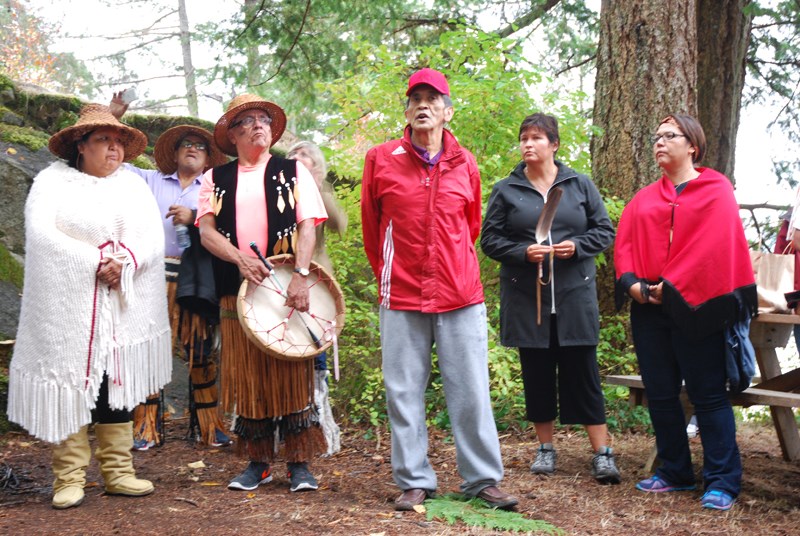Members of the shíshálh (Sechelt) First Nation marked their return to Pender Harbour in a longhouse blessing ceremony last week on lands near Garden Bay that remain technically under a provincial park designation.
“We’re here today to celebrate the rehabitation of our land,” Chief Calvin Craigan said during the ceremony on Thursday, Sept. 18, attended by dozens of Band members and guests that included Sunshine Coast Regional District (SCRD) directors and neighbouring First Nations.
While he addressed the crowd under a light rain, Craigan said the longhouse, built by shíshálh artist Shane Jackson on a bluff overlooking the sea, symbolizes a reversal of the order that forced their people from the area generations ago.
“We are now returning to our original territory. What you are witnessing today is a celebration of bringing back the longhouse, bringing back the culture of this land, bringing back the spirit of this land.”
The Sechelt Nation will be “very visible on our land from this day forward,” Craigan vowed. “We are sending a message to the governments that we are going to relocate, we’re going to inhabit our lands, we’re going to use the resources and protect the resources in our land.”
In an interview the next day, Craigan said the site — which is accessed from a forest path near the foot of Claydon Road — spans almost 12 hectares.
The longhouse will be used by Band members for cultural purposes, and will also be open to the public, he said.
“We see it as a piece of land that we’ve always inhabited, but we’re sharing still.”
Craigan said he hoped to meet soon with Pender Harbour community members.
“We would like them to accept our gift of the longhouse. We want them to feel free to use it. We will be hopefully planning other functions in the longhouse with them so they can be more familiar with our culture.”
The longhouse will be one of six in the area to be established this winter, each of them on Crown land about 12 hectares in size, he said.
“With ones we’re planning at the head of Jervis Inlet, we are going to be demonstrating to not only the community but to our own people that they can start going back to the traditional villages and utilize the longhouses for whatever purposes, whether it be for hunting, fishing, camping. We want our people to start going back and utilize our own resources again, whereas they have been denied before.”
Those sites will also be open to the public, he said.
Contacted Tuesday, the provincial government confirmed the longhouse was built in the day use area of Garden Bay Marine Provincial Park, which is Crown land, and said BC Parks staff determined the structure is sound and does not pose any public health or safety risks.
“Work done in the past on the park’s master plan recognizes the values and archeological significance of Garden Bay Marine Provincial Park to the Sechelt First Nation,” the province acknowledged in an emailed response.
The province said the status of the longhouse is expected to be part of discussions aimed at reaching a reconciliation agreement.
John Rustad, Minister of Aboriginal Relations and Reconciliation, said in a statement to Coast Reporter: “The province understands that the management of Pender Harbour is a long-standing issue with the Sechelt First Nation. We are committed to good-faith negotiations that will lead to reconciliation and improved economic and cultural opportunities for the people of Sechelt First Nation.”
At Thursday’s blessing, master of ceremonies Candace Campo called the village site “profoundly important” to the Sechelt people, who once densely populated the area.
“The Sechelt people consisted of four clans. This clan was the killer whale people, but it was also the permanent site for the Sechelt Nation,” Campo said. “Our clans and our chiefs from the other areas also had their longhouses here, because it was a central place for our people.”
The Band’s move follows the Supreme Court of Canada’s historic Tsilhqot’in decision affirming Aboriginal title to Crown land on traditional First Nation territory, and was planned in the weeks leading up to Premier Christy Clark’s meeting with B.C. chiefs in Vancouver on Sept. 11, Craigan said Friday.
“Of course we’re well aware that she has made empty promises in the past, not only to other First Nations, but to Sechelt — and it was in regards to reconciling in the Pender Harbour area, the docking system, the access to our natural resources in our bays.”
Anticipating Clark’s statements to the chiefs, the longhouse “was pre-fabbed and ready to go,” Craigan said.
The message to Clark, he said, was that “this land still belongs to us, we haven’t ceded it and we don’t recognize the province’s tenure. And we have the cooperation of the local governments in that regard.”
SCRD chair Garry Nohr, called as a witness at Thursday’s ceremony, reflected on the beauty of the site and told Band members, “No wonder you don’t want to give it up and want it back, and I wish you well in achieving that and working for it. I hope the regional district will stand by you in your next journey.”
The longhouse was so impressive, Nohr quipped, that he’d “love to have it in my backyard.”
District of Sechelt councillor and SCRD director Darnelda Siegers, also called as a witness, described the longhouse as “a symbol not only to you and your people but to us, who are the latecomers. This is saying that you are here and you are going to stay, and that we should listen to you, pay attention to you and take what you have to say to heart. So I would say welcome home.”
Howard Paull conducted the blessing, opening with a prayer of thanks and closing the ceremony by blessing the longhouse interior with cedar boughs. Accompanied by Craigan, the drum group xwamstut played traditional shíshálh songs, culminating in The Victory Song.



